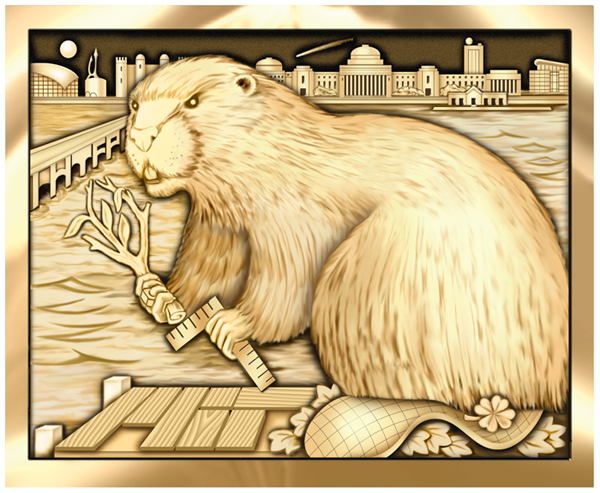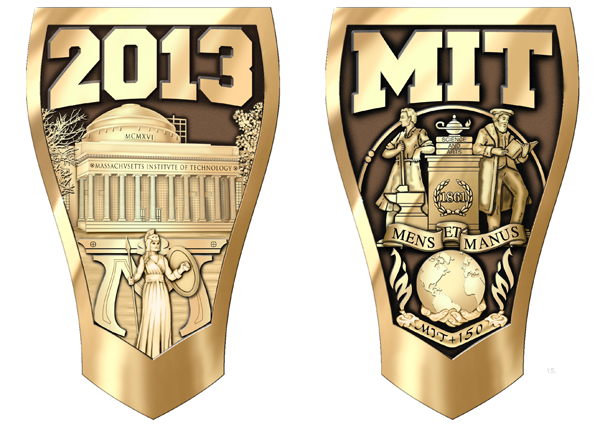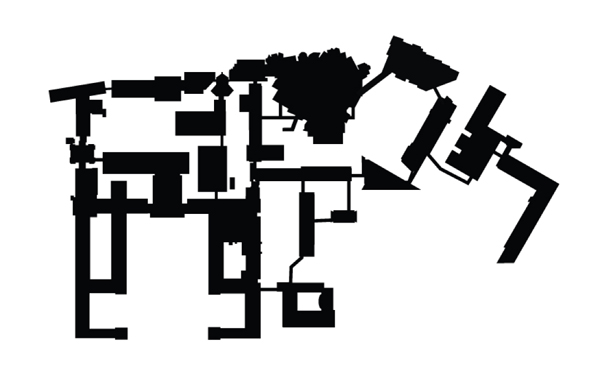Design
Bezel

For the first time, the beaver sits on the dock of the Charles River Esplanade, fiercely gazing at us with both eyes. In the beaver’s right hand is a branch, its four leaves representing our four years of undergraduate study here at MIT. The branch turns into the scroll of a diploma. A “13” is visible in the negative space of the branch. The beaver also wears his own 2013 Brass Rat. In his left hand the beaver clutches a framing square, which is in the shape of a 7 with 13 notches on its sides. The 7 represents the UN’s predicted world population in 2013 of 7 billion people. He is using the framing square and his natural engineering abilities to construct the dock, leaving behind the MIT logo. The beaver sits on 8 ivy leaves, much like MIT is on top of academia. Cradled in the beaver’s tail is a four-leaf clover, representing good fortune, in spite of negative connotations with our class year, thirteen.
Engraved in the Charles River are two of MIT’s colloquialisms, ‘Punt’ and ‘Tool.’ On the left side of the bezel is the Mass Ave Bridge, connecting MIT’s campus to Boston. In the arches of the bridge are the letters IHTFP. Featured behind the beaver is a skyline of MIT’s campus, including the new Media Lab, Walker Memorial, the Green Building, and the two domes. In front of the academic buildings is the Sailing Pavilion. On the other side of Mass Ave is Maseeh Hall, the MIT chapel, and Kresge Auditorium. In the sky are a shooting star and a full moon, commemorating the 500th anniversary of Copernicus’s original thesis in the year 2013.
Class and Seal Shank

The Class Shank depicts an angled view of Killian Court and Building 10. On the side of the Great Dome is a hint of scaffolding, reminding us of the dome’s restoration during our freshmen year. Since we are MIT’s 146th graduating class, the crown molding around the dome is divided into sections with one, four, and six hashes. As on the actual Great Dome, MCMXVI is on the front. This number represents the year MIT moved from Boston to Cambridge.
Killian Court is framed by a barren tree on the left and a blooming tree on the right, signifying the changing seasons, as well as hinting at our love-hate relationship with MIT. The lower half of the shank features Athena, the Greek goddess of war, wisdom, and strength, and the name of MIT’s computing environment. Behind her sits the older “nuts and bolts” symbol of MIT.
The seal shank depicts MIT’s authentic seal. The seal is inscribed with 1861, the year MIT was founded. MIT’s motto, “Mens et Manus,” Latin for “Mind and Hand,” describes the physical and intellectual tools we use every day. The seal features a student and a teacher as well as the lamp of knowledge, which exhibits our devotion to academic excellence. On the outer rim of the seal, two atoms are colliding, referencing CERN’s Large Hadron Collider, the world’s largest and highest-energy particle accelerator that experienced its first successful collision during our freshman year.
The globe beneath the seal is held in two hands, just as we, MIT’s Class of 2013, have the world in our hands. The globe also represents the MIT Green Initiative as well as our campus’s support for victims of recent natural disasters. The candle, burning at both ends, represents our late, sleepless nights and long hours of work. Inscribed in the candle is “MIT + 150″ to commemorate MIT’s celebrations for its 150th anniversary this year. The flames of the candle are mirror images of each other, on the left, the flame reads “13,” the right side reads “MIT.”
The Skylines

The Cambridge skyline is depicted during the day to represent the time we spend on campus for classes. It stretches from Kresge Auditorium to the new Media Lab. Other buildings portrayed on the skyline include: the Student Center, Maseeh Hall, the MacLaurin Buildings, the Green Building Walker Memorial, and Tardis, which appeared around campus as a hack this past fall. The windows of the Green Building are illuminated to read “2-0-1-3″ in binary. In the water below the skyline is a sailor hiking out of his boat. A small crew boat is also shown, acknowledging MIT’s only Division I sport. Flying in the sky is a V-22 Osprey, the military aircraft that visited campus during the spring of our freshman year.
On the far right of the Boston skyline is Fenway Park, a herald to the city’s athletic traditions. The Goodyear Blimp flies nearby. Also prominent is the Citgo Sign, as well as the Prudential Center and the Hancock Tower. The skyline is adorned with a crescent moon, featuring Boston in the nighttime, a view that we often see from campus.
The Hacker’s Map

The Hacker’s Map is representative of MIT’s longstanding hacking culture. It includes the academic buildings, as well as the newly opened Koch Institute, all connected by the underground tunnel system. The map is a symbol of the integrative and connected nature of everything from academics to leisure at MIT. It serves as a reminder of our time here as well as the hope that we will always be able to find where we are going in our lives after college.